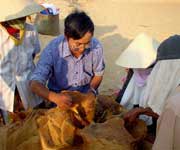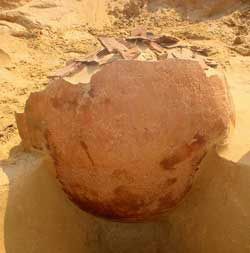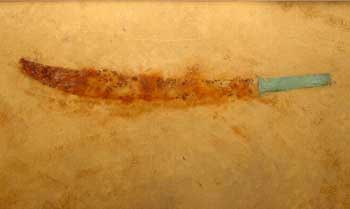The Excavation of the Gò Quê Tomb Reveals Fascinating Insights into Sa Huỳnh Culture: In Addition to Jars, They Also Buried the Dead in Earth Graves.
 |
| Archaeologists are excavating |
The Sa Huỳnh culture is well-known and quite familiar, having been discovered nearly 100 years ago. However, recent excavations have yielded many new artifacts and discoveries. Some of these intriguing findings were recently revealed during the excavation of the Gò Quê tomb earlier this year.
The first unusual story is the discovery of this tomb. If it weren’t for the land clearance for the construction of a shipbuilding factory in the Dung Quất industrial zone, the residents of Sơn Trà fishing village in Bình Đông commune, Bình Sơn district, Quảng Ngãi province would never have imagined that their village harbored a relic over 2,000 years old.
This tomb is nestled within a mound, with a depth of up to 4 meters from the top of the mound to the burial sites, a depth that no civil construction can reach.
Typically, burial sites are only dug shallowly, about 50 cm deep. So why did the people of Sa Huỳnh go to the trouble of digging such deep graves for their deceased? The answer will only emerge once the excavation site is completed and the original landscape is reconstructed. It turns out that the mound here was not initially as high as it is now.
The ancients also buried their dead at similar depths as in other places. However, after over 2,000 years, a large mound has buried the entire tomb complex. The culprit behind this is… the wind. The burial area is subject to strong winds blowing in from the bay, causing sand dunes to drift across a wide area, completely covering the ancient tombs today.
The second unusual occurrence is the burial practices of the ancients. For nearly a century of discovering and studying Sa Huỳnh culture, scientists have believed that the Sa Huỳnh people were associated with the practice of burying their dead in jars. There may be differing opinions on how jars were used.
 |
|
A jar burial. |
For example, some suggest that the whole body was placed inside the jar and then sealed, while others believe that the body was cremated first, and only the ashes were placed in the jar (a form of cremation). Some scholars have even gone so far as to hypothesize that there were never any… corpses in the jars, but rather it was a symbolic burial. Since the Sa Huỳnh people were connected to the sea and their livelihoods depended on the coastal currents, when they died, they returned their bodies to the sea; only upon reaching the shore did they bury jars and grave goods in the sand as a way to honor the deceased…
Despite various opinions still being debated, there appears to be a consensus on one point: the ceramic jars are inextricably linked to the burial customs of the Sa Huỳnh people as an immutable criterion. In fact, in some areas like the Sa Huỳnh estuary in Đức Phổ district, Quảng Ngãi, when they were first discovered in the early 20th century, there were so many jars that the French archaeologist H. Parmentier had no words to describe it other than “Sa Huỳnh Jar Cemetery.”
However, recent documents suggest otherwise, particularly in the Gò Quê tomb area. In addition to jars, they also buried the dead in earth graves. The deceased were laid down, with ceramic items smashed and even whole jars broken to scatter fragments around the body. The ratio of earth graves to jar graves here is 13 earth graves to 18 jar graves, indicating that the ancients had two burial methods, with similar grave goods and ceramic fragments.
Not many Sa Huỳnh burial sites exhibit both burial practices like this. This also helps challenge the hypothesis that the Sa Huỳnh people discarded their dead bodies into the sea. In fact, they did bury their loved ones in jars (recent scientific experiments have shown that a jar can indeed hold a body if it is maximally shrunk to the fetal position) as well as laying them flat (the length of the grave and the arrangement of the ceramic fragments correspond to the height of an adult).
The third unusual finding pertains to the grave goods at the Gò Quê tomb. Archaeologists were astonished to find a series of bronze artifacts from the Đông Sơn culture here, giving the impression of excavating a true Đông Sơn cultural site, unmistakably distinct from others. Notable items include: six rectangular bronze axes with geometric patterns, a balanced axe with a fish-tail-shaped socket, leaf-shaped spearheads, and T-shaped hand guards on daggers, as well as breastplates adorned with spiral patterns.
This indicates that, at that time, the two ancestral ethnic groups of the Vietnamese and the Cham were already engaged in trade and exchange. Previously, based on available documents, French archaeologist M. Colani believed that Đông Sơn bronze artifacts only reached as far as Cương Hà and Cổ Giang (Quảng Bình). Now, it seems that Đông Sơn bronze artifacts have extended even further, at least to northern Quảng Ngãi, the center of Sa Huỳnh culture.
The fourth unusual story: for the first time, archaeologists discovered a unique artifact. This was a sword with an iron blade but a bronze handle. Artifacts made from both metals are rarely found in Vietnam and are considered a type of “copper-iron alloy.” The sword is exquisitely crafted, particularly the bronze handle, which consists of multiple tubes and rings assembled around a wooden core.
This excavation also yielded another spear made from the same two metals. It is noteworthy that the sword, which combines the techniques of iron forging in a jar grave, indicates that the ancients here placed great importance on iron smelting materials and had indeed mastered iron production on-site. The products and evidence of iron smelting have refuted previous notions that the Sa Huỳnh people acquired iron goods through imports.
The fifth unusual occurrence deals with the clothing of the ancients. Many historians, based on the historical records of Sima Qian, assert that the people of the Đông Sơn culture did not know how to wear clothes. However, recent archaeological discoveries at the Gò Quê tomb have shown that the ancients were aware of clothing. Scientists found ceramic spindle whorls used for spinning threads to weave fabric.
Fabric traces were also found on a bronze axe, still intact with threads woven in the simplest manner, one horizontal thread alternating with one vertical thread. It is likely that the threads were made from a type of fiber, as some similar fiber samples have been analyzed previously. The clothing was also dyed with indigo. Traces of blue indigo dye remain imprinted on many bronze artifacts.
 |
|
The bronze-handled sword with an iron blade found in the excavation pit. |
For the first time, archaeologists discovered a set of bronze buttons in the Gò Quê tomb. The buttons consist of 10 pieces that resemble modern buttons, round with four holes for sewing onto garments. Traces of thread are still visible between these holes. Thus, for the first time, we have clear evidence of an aspect of civilization over 2,000 years ago among our ancient ancestors: the aspect of dressing elegantly.
The sixth unusual finding concerns jewelry. In many Sa Huỳnh burial sites, numerous colorful glass beads and red agate beads have been discovered. The Gò Quê tomb also yielded many similar beads and strings. Notably, many mountainous regions of Quảng Ngãi and Quảng Nam still have ethnic groups using identical beads and strings.
The H’re people in Bát Tơ district still wear jewelry similar to that of the ancient Sa Huỳnh. People in the Hiên and Rằng districts are so fond of agate jewelry that recently, locals have been known to trade two or three buffalo for a string of diamond-shaped agate similar to that of Sa Huỳnh culture. It seems that the cultural imprint of Sa Huỳnh still lingers in the jewelry worn by the highland girls.
This also opens up hypotheses for scientists about the relationship between the ancient Sa Huỳnh people and many modern ethnic groups, as well as the connection between coastal and mountainous cultures throughout the millennia of cultural advancement in Central Vietnam.
New and intriguing discoveries about Sa Huỳnh culture continue to emerge in its original territory. Scientists increasingly recognize the vibrant life and astonishing creativity reflected in the unique artifacts of the Sa Huỳnh inhabitants. They truly mastered the East Sea and a vast coastal region. They often established villages near major estuaries like Sa Cần, where the Trà Bồng River flows into the sea (home to the Gò Quê site), Sa Kỳ estuary (where Bình Châu is located), and Sa Huỳnh estuary. Another significant estuary is Đại, where the Trà Khúc River meets the sea, promising a rich array of Sa Huỳnh relics.
In addition to a series of coastal villages, the Sa Huỳnh people also established settlements on distant islands. Lý Sơn island district in Quảng Ngãi (which later became the starting point for Vietnamese maritime expeditions to the Paracel Islands) was also home to vibrant Sa Huỳnh communities, providing evidence that the Sa Huỳnh people had long been the true masters of the distant islands well before the feudal dynasties of Vietnam established administrative names and exercised sovereignty over these island territories.


















































